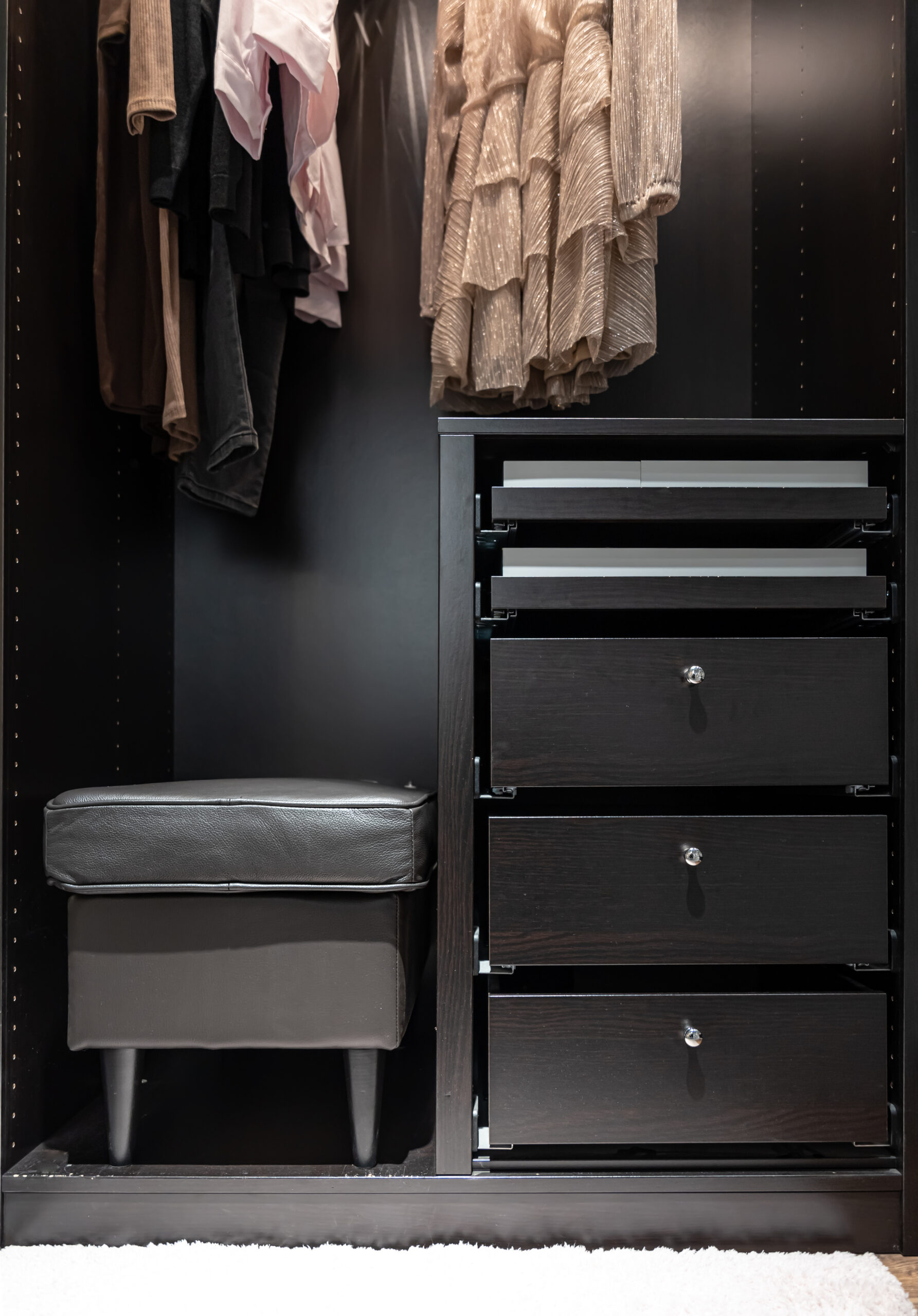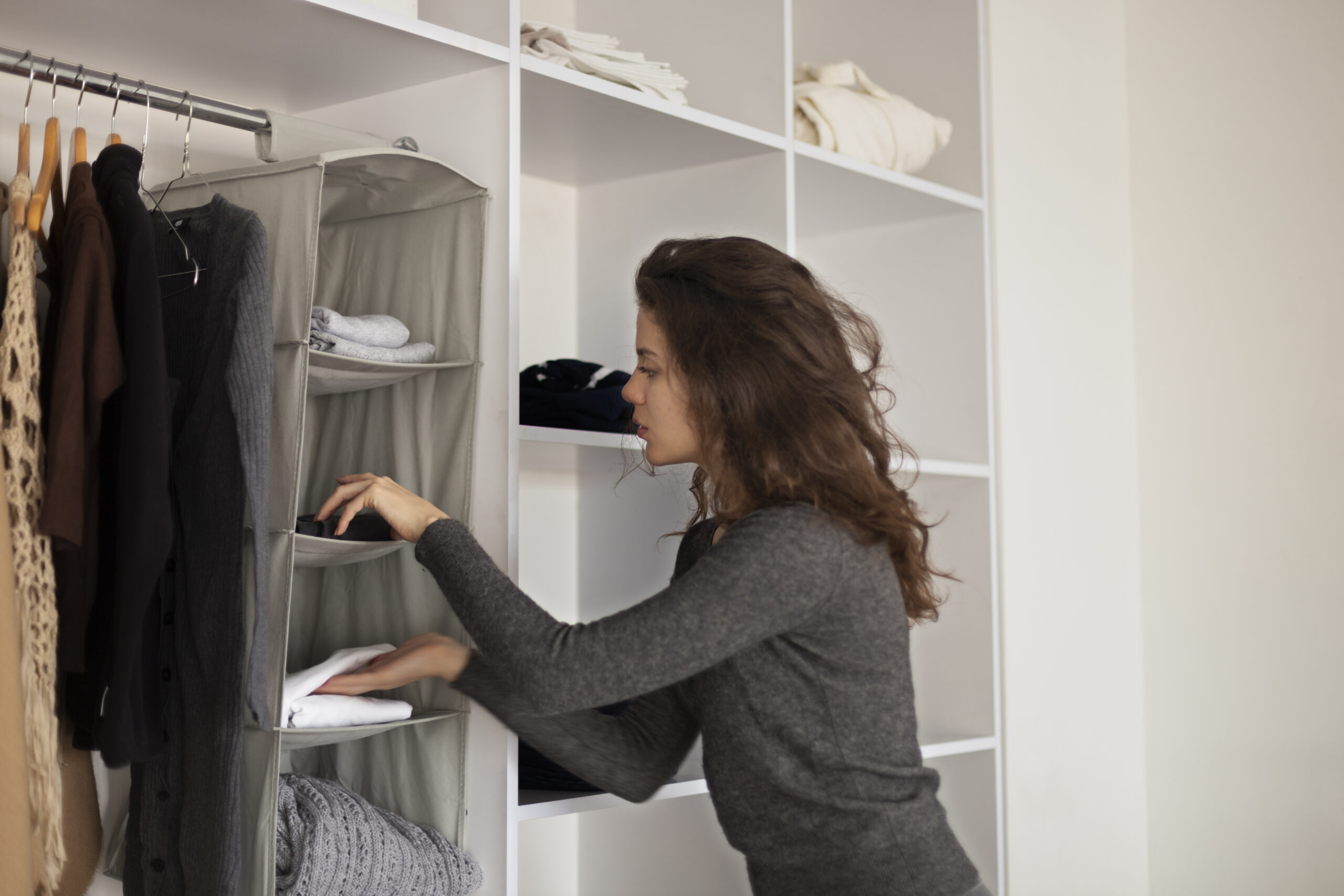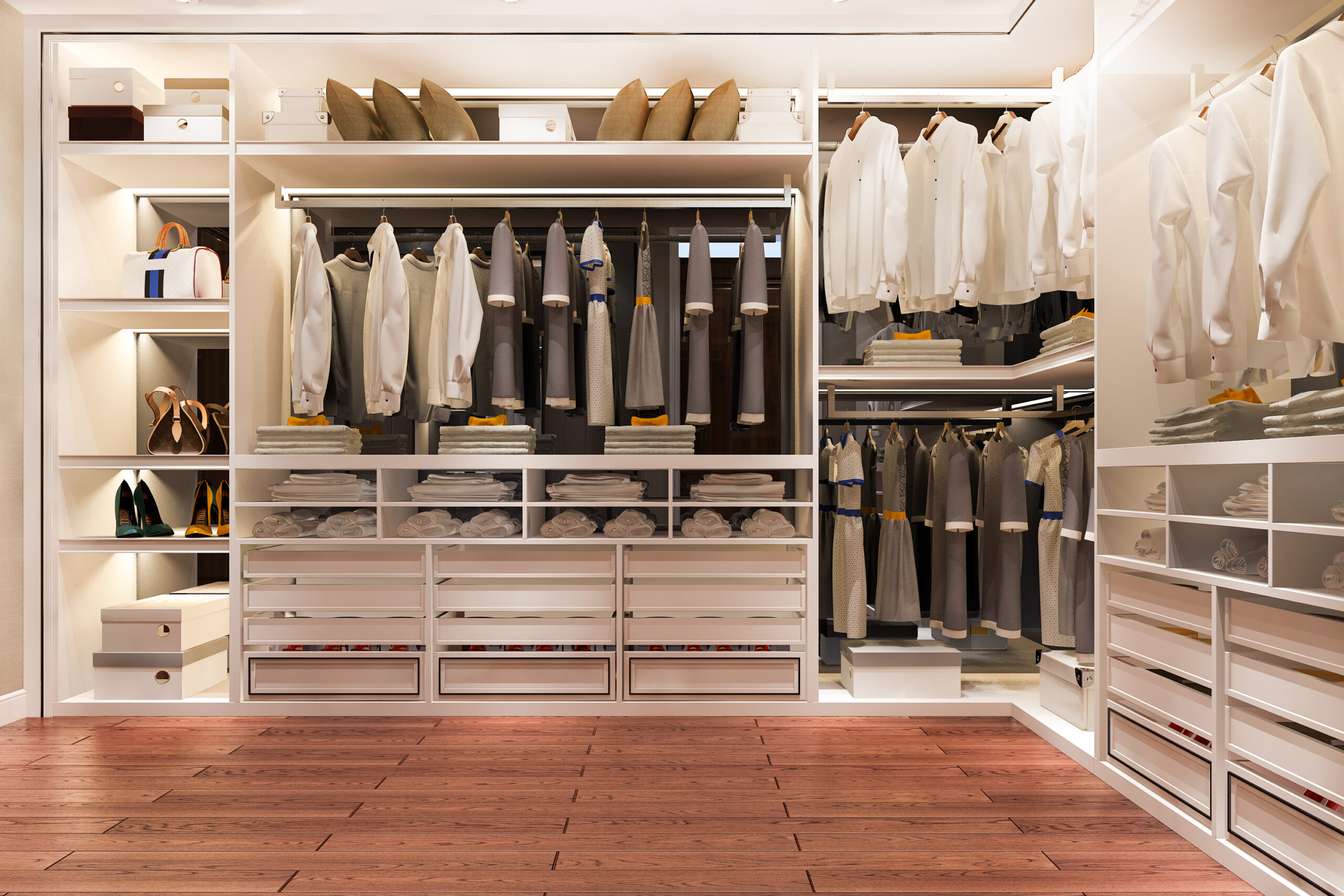DISCOUNTS ARE IN BLOOM! 30% OFF ALL CLOSETS!
Ciri Blog

Create Your Own Dressing Room: Walk-In Closet Ideas and Inspiration
Introduction to Walk-In Closets
Walk-in closets have gained considerable popularity in recent years, becoming a hallmark of luxury and practicality in modern homes. Unlike traditional closets, which often limit organization and accessibility, walk-in closets provide expansive space that allows homeowners to store clothing, shoes, and accessories in an orderly manner. Their design not only optimizes storage but also fosters an environment for personal expression, making them a sought-after feature for many house designs.
The functionality of a walk-in closet lies in its capacity to accommodate a variety of organizational systems tailored to individual needs. Shelving, drawers, and hanging space can be strategically arranged to maximize efficiency and ease of access. The inclusion of personalized elements such as lighting, mirrors, and seating areas enhances the overall utility, transforming the space from mere storage into a highly customized dressing room that reflects one’s style and lifestyle.
In addition to improving organization, having a dedicated dressing room adds significant value to any home. Real estate trends indicate that prospective buyers increasingly prioritize walk-in closets, recognizing them as a symbol of comfort and luxury. As a result, investing in a beautifully designed walk-in closet can yield favorable returns in terms of resale value while also enhancing daily living experiences.
The appeal of customization cannot be overlooked. Creating a walk-in closet allows homeowners to choose materials, finishes, and layouts that resonate with their tastes and preferences. This flexibility opens the door to a multitude of design possibilities, ensuring that the space does not only serve functional purposes but also provides aesthetic enjoyment. Whether one envisions a sleek, modern look or a warm, traditional vibe, walk-in closets can easily adapt to simulate the desired ambience.
Assessing Your Space
Creating a functional and aesthetically pleasing walk-in closet begins with a thorough assessment of your available space. The first step is to measure the dimensions of your existing room or attic. This process entails taking accurate measurements of the width, depth, and height of the area designated for your closet. Utilizing a tape measure and notepad can prove invaluable, as recording these dimensions will aid in visualizing how the closet can fit within the confines of the space.
Next, consider any architectural elements that may impact your design choices. Windows, doors, and beams are critical aspects to evaluate as they influence both the layout and functionality of your walk-in closet. For instance, windows provide natural light, making the space more inviting; however, they can also limit wall space for storage solutions. Similarly, doors must be factored into the design, ensuring they do not obstruct closet access or functionality. Beams may pose additional challenges, requiring creative solutions to work around them without compromising design integrity.
In addition to measuring and identifying structural elements, it’s crucial to evaluate your individual storage needs. Reflect on the items you intend to store within your closet, such as clothes, shoes, and accessories, and consider how best to organize these pieces to maximize functionality without sacrificing style. Utilizing shelves, racks, and dedicated storage areas for various items can enhance the efficiency of your design. Prioritizing your storage needs will not only inform your layout choices but also ensure that your walk-in closet remains a practical space tailored to your lifestyle.
Design Inspiration: Layouts and Styles
When designing a walk-in closet, one of the most crucial decisions involves choosing the layout that best suits your space and style preferences. There are several popular layouts, including U-shaped, L-shaped, and linear designs, each offering unique advantages and aesthetics. These layouts can enhance functionality while contributing to an appealing visual experience.
The U-shaped walk-in closet is ideal for those with ample space, providing three walls of storage that maximize organization. This design allows for a central walkway, creating an open environment where you can easily access clothes, accessories, and shoes. U-shaped closets are versatile, accommodating various storage solutions, such as hanging rods, shelves, and drawers, resulting in a highly efficient organization system.
In contrast, the L-shaped closet is a perfect option for smaller spaces without sacrificing style. The corner design optimizes the available area, creating a functional corner while maintaining accessibility. This configuration often includes built-in shelving and cabinetry, providing ample storage while allowing for a seamless transition into the rest of the room. Alternatively, adding mirrors to an L-shaped layout can enhance depth and create an illusion of space, making it feel larger than it is.
Linear walk-in closets provide a streamlined approach, ideal for long and narrow spaces. This layout offers a straightforward design that emphasizes minimalist aesthetics, encouraging a clean and uncluttered appearance. With all items positioned along one wall, finding and accessing your wardrobe becomes straightforward. Adding a well-placed island or seating area can further enhance functionality, turning it into a practical space for dressing and organizing.
Regardless of the chosen layout, incorporating personal touches such as color schemes, lighting, and decor will add character and inspiration to the design. Whether you gravitate toward a minimalist approach or seek a luxurious atmosphere, the options are vast, making it possible to create a dressing room that truly reflects your personal style.
Choosing the Right Storage Solutions
Designing an efficient walk-in closet necessitates careful consideration of various storage solutions. The optimal combination of shelving, hanging rods, and drawers is pivotal for achieving an organized and accessible space. First, assess the types of clothing and accessories you have, as this will guide the selection of appropriate storage options. For instance, longer garments such as dresses and coats require ample hanging rod space, while shorter items like shirts can be stored on double hanging rods, maximizing vertical space.
Shelving is another critical element in your closet design. Adjustable shelving units provide flexibility, enabling you to modify the layout as your storage needs evolve. Consider materials that offer both durability and style, such as wood or melamine, which can also complement the existing decor of your home. Incorporating dedicated shelving for shoes can enhance organization, while also alleviating clutter on floors or other surfaces.
Drawers are essential for securing smaller items such as accessories, undergarments, and folded clothing. Opt for soft-close drawer mechanisms to add a touch of luxury while preserving functionality. To enhance the storage capability, integrating accessories such as jewelry organizers and tie racks can further streamline your belongings, making them easier to access and manage. The configuration of these storage solutions should always prioritize ease of use, ensuring daily accessibility and clarity.
Ultimately, the aesthetics of your storage solutions can significantly contribute to the overall vibe of your walk-in closet. Combining varied textures and finishes can create visual interest while maintaining a cohesive look. Thoughtful selection of storage solutions not only enhances functionality but also transforms your walk-in closet into a personalized dressing room that meets all your organizational needs.
Lighting: The Key to a Functional Closet
Effective lighting is crucial in any walk-in closet, as it not only enhances the functionality of the space but also contributes to its overall aesthetic. The primary goal of closet lighting is to create a bright, inviting area that allows for easy visibility of clothes, shoes, and accessories. To achieve this, it is essential to consider multiple lighting options, each offering unique benefits.
Overhead fixtures, such as flush mount or chandelier lights, provide general illumination and serve as focal points in the design. These fixtures should be placed centrally to evenly distribute light throughout the space. Additionally, installing dimmer switches can allow you to adjust the brightness according to your needs, making it easy to transition from an everyday setup to a dressing environment for special occasions.
Incorporating LED strip lighting is another effective approach to improving visibility in a walk-in closet. These strips can be installed along shelves, above hanging rods, or within cabinetry to illuminate darker areas. The use of LED lights not only offers a bright, energy-efficient solution but also adds a modern touch to the overall design. Furthermore, consider utilizing motion-sensor lighting for a more convenient option, ensuring the space is illuminated as soon as you enter.
Natural light sources should not be overlooked when designing a walk-in closet. If possible, positioning windows strategically can enhance the ambiance and overall brightness of the space. However, it is vital to incorporate window treatments that allow for privacy while still letting in ample sunlight. In selecting light fixtures that complement the design, aim for styles that harmonize with the overall decor of the closet. This approach not only enhances the space’s functionality but also ensures that the lighting aligns with your personal taste.
Personal Touch: Decor and Accessories
When designing a walk-in closet, the decor and accessories play an essential role in creating a personalized and inviting atmosphere. The selection of wall colors is a crucial first step; opting for shades that reflect personal style can transform the space. Soft neutrals, pastels, or even bold accent colors can tailor the dressing room to match one’s taste. Painting the walls in a calming hue can also enhance the overall ambiance, making the area more enjoyable to spend time in.
Incorporating art pieces can add character and flair to your walk-in closet. Choose artwork that resonates personally, whether it be framed photographs, modern prints, or inspirational quotes. Hanging a few carefully chosen pieces can inject creativity into the space while making it feel uniquely yours. Layering mirrors not only serves aesthetic purposes but also enhances functionality. A full-length mirror is an indispensable addition, allowing for a complete view when trying on outfits, while decorative mirrors can make the space feel larger and brighter.
Flooring is another key component in walk-in closet design. Options like plush carpets add warmth, while luxury vinyl or hardwood can impart a sleek, sophisticated touch. When deciding on flooring, consider comfort and practicality, as this area often sees daily use. Lastly, functional decor is vital for maintaining organization without compromising style. Decorative baskets, stylish storage boxes, and elegant bins can help keep items neatly stored while contributing to the room’s overall decor. Opt for pieces that blend both functionality and aesthetics, such as rattan or fabric items that provide an organized yet chic appearance.
Incorporating Technology for Smart Organization
In today’s digital age, the integration of technology into walk-in closets has become an essential component of enhancing organization and functionality. Advanced closet systems now provide features that maximize space efficiency and streamline the process of managing one’s wardrobe. Smart closet solutions utilize modular shelving units, adjustable rods, and built-in lighting that can be customized to suit individual needs, allowing users to optimize their storage capabilities effectively.
Another innovative addition to walk-in closets is the use of smart mirrors. These mirrors not only serve as reflective surfaces but are also capable of displaying personalized information, such as outfit suggestions based on the time of day or upcoming weather conditions. Additionally, some smart mirrors integrate technology that can connect with wardrobe management apps, effectively assisting users in selecting their outfits and keeping an organized view of their clothing inventory.
Moreover, organization apps have emerged as a valuable tool for managing wardrobe inventory. These applications allow users to take photographs of their garments and categorize them according to various criteria, such as color, occasion, or season. With these applications, users can easily track what they own, plan outfits in advance, and even set reminders for items that are seldom used or require maintenance. Features such as virtual outfit planning and occasion-based suggestions transform the way individuals interact with their clothing, enabling a more efficient and satisfying dressing experience.
Moreover, technology-driven solutions extend to garment care as well. Devices such as fabric freshening units and smart steamers can help maintain the quality of garments without excessive wear and tear. Integrating such innovative technologies into walk-in closets not only promotes organization but also elevates the overall experience of wardrobe management, making it a seamless part of daily routines.
Budgeting Your Walk-In Closet Project
When planning the creation of your own dressing room with a walk-in closet, budgeting effectively is crucial to ensure that the project aligns with your financial capacity while meeting your design needs. Start by establishing a clear overall budget, which will serve as a guideline for all subsequent expenses related to the project. This initial figure should consider all facets of the undertaking, including materials, labor, furnishings, and any additional decor items.
The cost of materials can vary significantly based on the choice of cabinetry, shelving, flooring, and lighting. For instance, custom-built cabinetry will generally incur higher costs than ready-made alternatives. Therefore, it is prudent to conduct thorough research and obtain multiple quotes from suppliers and contractors. Consider including mid-range materials that offer a balance between affordability and quality. Investing in good-quality materials can provide longevity and enhance the overall aesthetic of your walk-in closet.
Labor costs can also contribute substantially to the overall expenditure. Depending on the complexity of your design and whether you opt to perform the work yourself or hire professionals, these costs might fluctuate. Evaluate the extent of work you can undertake personally and prioritize hiring professionals for tasks that require specialized skills, such as electrical work or complex installations.
As you approach furnishing your walk-in closet, identify the essential items that prioritize functionality and organization. Consider custom storage solutions that optimize space while also reflecting your personal style. You can find affordable alternatives by exploring second-hand options or discounted stores. Keeping a flexible mindset will enhance your ability to adapt and find solutions that maintain quality without breaking the bank.
Ultimately, developing a well-thought-out budget and prioritizing your spending will not only help you manage your finances but also enable you to create a stylish and functional walk-in closet that you will love.
Maintenance and Organization Tips
To maintain an organized and visually appealing walk-in closet, a systematic approach is essential. One of the key strategies is seasonal wardrobe rotation. As seasons change, evaluate your wardrobe and remove items that are no longer relevant for the upcoming season. This not only ensures that everything current is easily accessible but also provides an opportunity to identify pieces that might benefit from repair or donation, thus promoting a minimalist ethos within your dressing space.
Regular decluttering practices are integral to maintaining order. It is advisable to schedule decluttering sessions every few months, during which you should critically assess your belongings. If an item has not been worn in over a year, consider whether it adds value to your collection or merely occupies space. This perspective will aid in developing a functional and curated wardrobe that aligns with personal style and needs.
To enhance organization, utilize various storage solutions effectively. Use clear bins for shoes and accessories, as this allows visibility while safeguarding items from dust. Additionally, hanging organizers can be an excellent way to maintain the neatness of items such as ties, belts, and scarves. For clothing, consider using matching hangers to create a harmonious look that visually appeals to the eye.
Implementing a system for quick access significantly enhances the functionality of your walk-in closet. Categorize clothing by type or frequency of use, placing everyday items at eye level and seasonal pieces higher up or towards the back. Moreover, using dividers within drawers can prevent chaos and clutter. By strategically organizing the closet, every item can be easily located, allowing for seamless dressing and maintained organization over time.
Devon Lane

- Genel (16)
- Home Improvement (3)
- Reinvent Your Wardrobe with Modular Shelving Systems 08/26/2025
- Create Your Own Dressing Room: Walk-In Closet Ideas and Inspiration 08/18/2025
- Big Solutions for Small Spaces: Organized Living with Modular Closet Systems 08/10/2025
- 5 Easy Cabinet Assembly Tips for Hassle-Free Pi Closets Installation 08/02/2025
- 10 Genius Shoe Storage Solutions: Try a Shoe Cabinet with Drawers 07/25/2025






